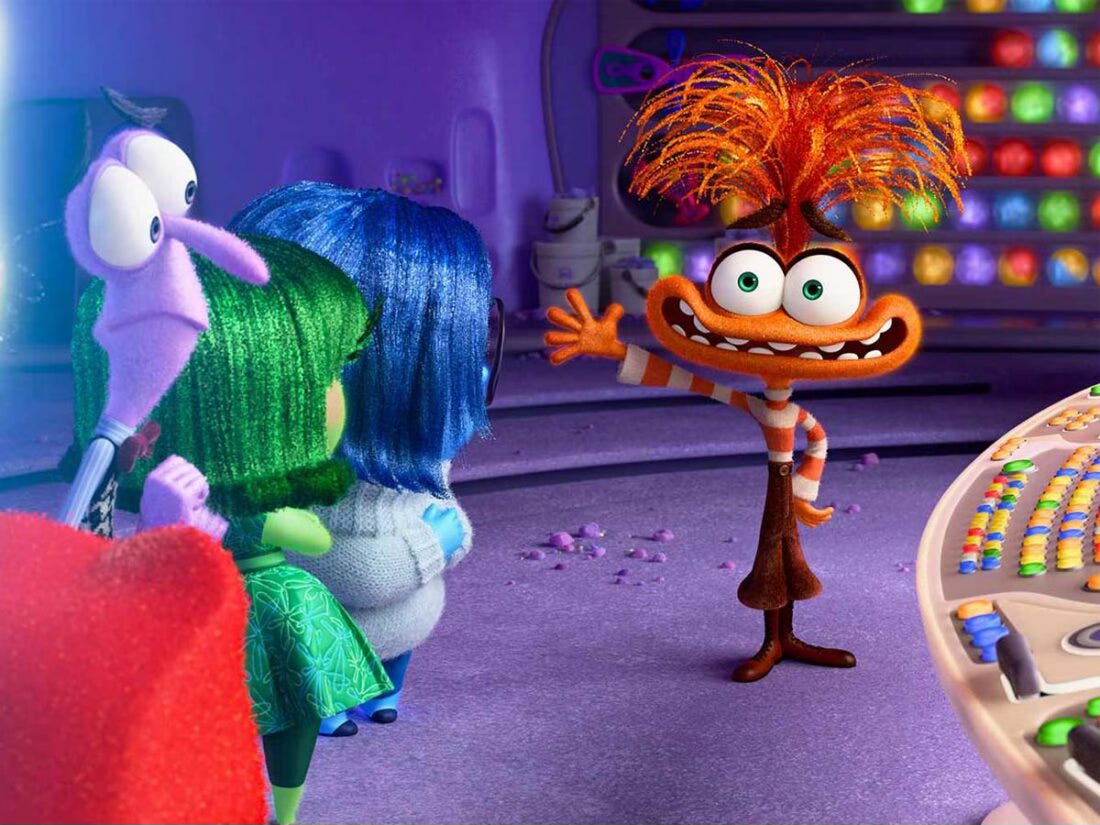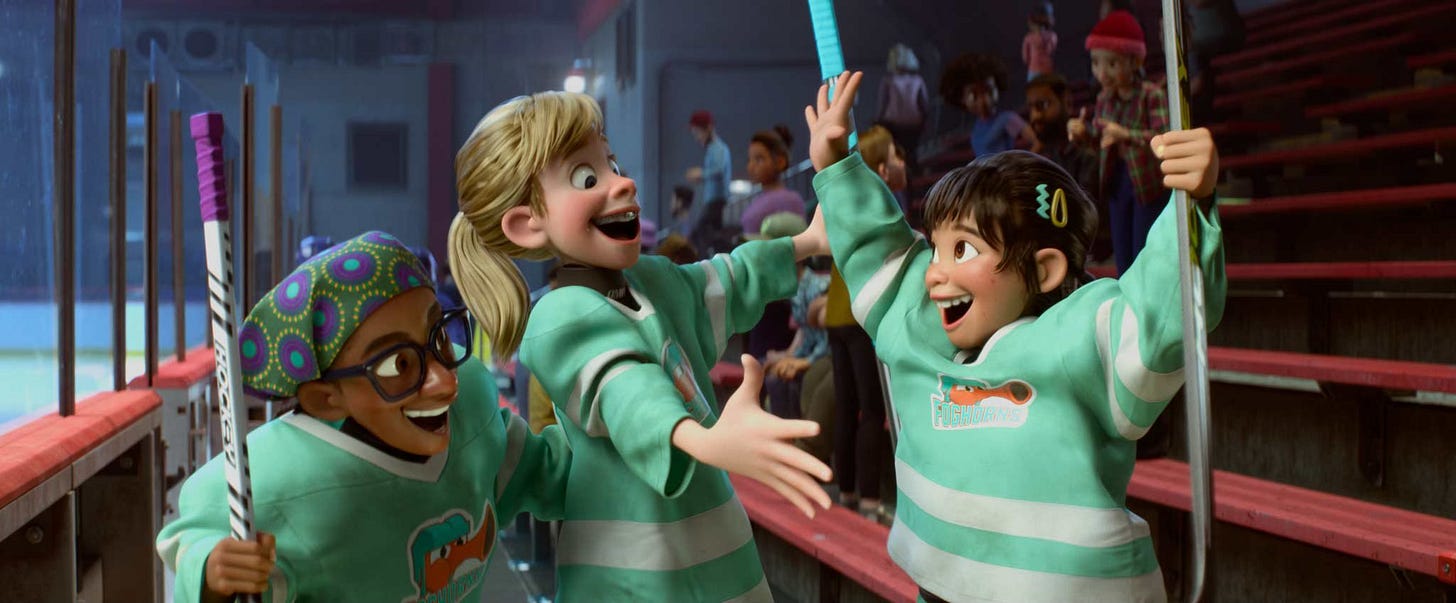Inside Out 2: a Stoic Mom perspective
Inside Out 2 shows us a young teen dealing with tough adolescent emotions. It's a highly imaginative portrayal, but from a Stoic point of view, it's missing a sense of how to build resilience.
This summer, my daughter invited me to go see the new Pixar movie Inside Out 2 at a nearby theater, and we sat among many other parent and child pairs and family groups taking it in. The film has been popular: just this past week, it hit $1 billion in international sales. It’s the sequel to 2015’s Inside Out, which followed the young Riley as she moved to San Francisco from the Midwest, and focused on her internal primary emotions—Joy, Fear, Anger, Disgust and Sadness—struggling to figure out how to handle the change.
The new film has fast-forwarded to Riley becoming a teenager. It meant a lot to me to see it with my now-teen daughter. In this post, I have some thoughts I’d like to share from The Stoic Mom perspective on the film. (Side note: fundamentally, it’s a movie aimed towards kids and teens, so I realize that some of my critiques may not be super meaningful for the primary audience!)
Spoiler alert: you may want to stop here if you haven’t seen it yet and don’t want to know what happens.
Inside Out 2 is a beautiful, imaginative depiction of the inside of a child’s mind as she strives to manage the more complex emotions of adolescence. Main character Riley is entering puberty now, and the story focuses on 13-year-old Riley’s experience at an elite hockey camp in preparation for high school. She hopes to make the high school team and form friendships with the older hockey players she looks up to.
She’s excited and nervous about the camp—totally understandable feelings. As Riley enters the community of the camp, she spends a lot of time and effort trying to impress the older, more experienced high school players and the camp’s director/coach. The movie oscillates between Riley’s experiences in the real world and her mind’s inner workings, represented by her emotions. Riley realizes she doesn’t play as well as the older girls do, and her response is to panic as a new adolescent emotion, Anxiety, builds power inside her. Other new teen emotions haunt her interior, too, including Embarrassment, Ennui, and Envy. Behind the scenes, Riley’s “Sense of Self”—the core of her mind that was carefully curated and protected by her mostly-harmonious old emotions—is removed by Anxiety and the new emotions, and sent far, far away.
Here’s where I loved the movie: the filmmakers found an inspired way to show how when you are controlled by Anxiety, you risk developing a negative sense of self that drives you forward with self-critical, harsh voices, influencing your thoughts and behavior. A scene of Anxiety frantically moving in a whirlwind of activity operating on Riley’s mind rang true. I’ve been there myself—sometimes anxiety feels like a crazed robot taking over my brain, mechanically and automatically raising fears and causing a frenzied energy, which is not a good thing.
Also interesting is how the complex new emotions of adolescence lead Riley to less than ideal decisions about her behavior, as Anxiety in particular takes over her mind’s “console.” For example, to fit in, Riley snubs her old friends to try to build rapport with her new ones. And she sneaks into the off-limits office of the camp’s director to look at her private notebook, determined to see if it says whether Riley is a good enough player to make the high school team. In a rising crescendo of questionable choices, Riley becomes aggressive on the rink and gets sent to the penalty box, where she starts panicking as she sits alone.
As the story unfolds, what’s missing for Riley is the ability to manage her mind’s negative new messages, as thoughts like “I’m not good enough” and other harsh, self-critical voices make themselves heard while she struggles to compete and fit in. The voices drive her to behaviors that undermine what she is striving for. And in her mind, they invade the positive self-image she’s developed, exemplified by other internal thoughts, like “I’m a good person,” and “I’m a good friend.”
The plot develops in Riley’s mind as the primary emotions, kicked out by the new adolescent emotions, make a plan to regain control. Led by Joy, they go on an epic search to recover and return this Sense of Self to its proper place at center of her mind. It’s a hard journey and Joy nearly gives up. The primary emotions ride a wave of “tough” memories such as failing a test, disappointing a teacher, or being called out for a hockey penalty. They use that huge backlog, previously suppressed by Joy and the other primary emotions, to get back to fight against the controlling influence of Anxiety and try to replace the healthy Sense of Self to its old position. Joy realizes that pushing down difficult experiences out of Riley’s consciousness wasn’t a great idea after all. Riley reunites with her old friends (who are forgiving) and comes back into balance.
But what I think the filmmakers missed here was the opportunity to depict how Riley’s memories of challenges, setbacks, and mistakes could lead to growth—how she could learn to become more resilient and develop more self-compassion.
At the end, it seems that Riley is able to incorporate her difficult memories and experiences more. But it wasn’t too clear how that worked. If Riley took the time to feel through (and think through) the difficult times, she could discover how to cope and keep going when things don’t go your way, to realize that your self-worth is not based on your achievements such as winning a game, making a team, having the coolest friends, or being the best at something. A message that could be helpful here is the idea that we are all striving to improve ourselves and our character, in a Stoic sense.
Also, I would have loved to see more of a sense of the fact that you can’t fix everything in your life and make it go perfectly, but you CAN learn to tolerate distress, without anxiety completely controlling you. You WILL experience setbacks and difficulties and hard things, and that you can get through it. This would have helped Riley as she struggled with realizing she wasn’t perfect and had landed herself in the penalty box.
Another Stoic perspective that could be helpful here is that our emotions and thoughts in the moment are sometimes just knee-jerk reactions, that can be questioned and assessed before we take action. Riley moves without questioning when she has impulses (including breaking some ethical rules, like sneaking around to snoop on the coach’s notebook).
Granted, the approach I described above is VERY tough for young teens as they cope with the swirl of emotions, social pressures, and desires in an ever-changing landscape. They don’t have the self-awareness of adults. But I still would have liked more of an emphasis on that approach, rather than being saved by the emotion of Joy. It was good to see the recognition of tough and disappointing memories at the end, but we could have seen Riley figure out to handle stress by realizing it is OK when things do not go your way.
At the movie’s end, the primary emotions re-attach Riley’s Sense of Self to her mind’s console, and it blends together with the anxious, embarrassed, envious, and bored thoughts that adolescence has brought her. She becomes a more complex person who can do her best to manage both positive and negative thoughts.
The movie doesn’t really address the things that are outside Riley’s power (in a Stoic sense), like the fact that a high school coach might decide against adding Riley to the team. In a way, the film seems to build a bit of an illusion that Riley, through the guidance of her complex emotions, is really in charge of everything around her.
One of the lessons my teens (and I) have learned is that this isn’t always true; Stoics take this lesson seriously. Decisions will be made by organizations, institutions, and authority figures that aren’t always fair or what you expect. Opportunities aren’t always what they seem. And people can let you down. A Stoic approach would be to persevere while questioning our impressions, drawing on our spark of reason, and acting out the virtues to live as well as we can in this chaotic world. I’d love to see a future film showing a kid like Riley doing that, too—and developing her character along the way.









Excellent points. The most important piece for the writers and filmmaker to include in this story would have been the reality you bring up and how the characters could have collaborated (like different parts of our inner dialogue) in order to integrate and understand different sides and feelings so that they go from conflicted to less polarized.
I love the points you've raised in this article. Coping with things beyond our control is at the heart of stoic teaching. Being able to face challenges and personal disappointments is part of life and the resilience we build comes from our ability to discern what is in our control and what isn't. When we reflect on our own bad moments where we wish we had made better decisions, we can grow. And when we know that what we've done is rooted in thoughtful judgment, yet the outcome is undesirable, we still need to remember who we are and not tie our identity to the outcome. Perhaps a 'resilience center' in Riley's brain (in some form) would have helped tie together the negative memories with growth and sense of self. If I imagine it, its (resilience's) structural strength would comprise of 'negative' memories and then those would be held together or tempered by processing/judgment. The two elements would work together to bolster one's sense of self. As in the movie, the 'negative' memories would serve an important purpose. Only now we add in processing/judgment, and the memories are reformed and repurposed into growth and strength, i.e. a strong sense of resilience (without processing/judgment, they would be a just in a heap, not helping us and being tossed around by Anxiety)...
With my own kids as they grow and develop, I hope to remind them to reflect on what they did, what decisions they made, and to recognize their identities through those thoughts and actions (and growth), rather than the reactions and outcomes that were beyond their control.